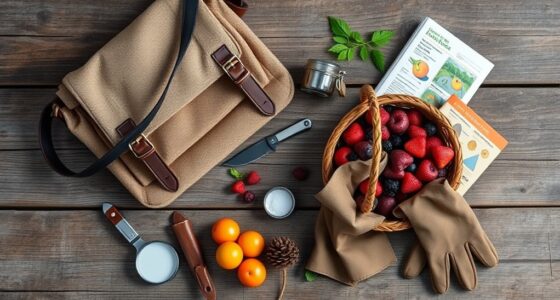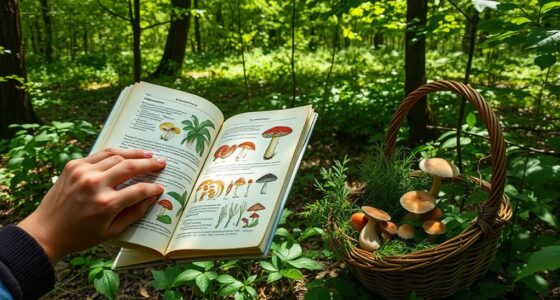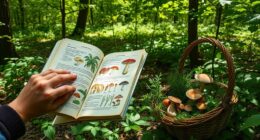When foraging for berries, you need to carefully identify edible varieties like blackberries, raspberries, blueberries, and strawberries, focusing on their colors, shapes, and habitats. Use tools like scissors and baskets, and wear protective gear to stay safe. Always verify that berries are ripe and free from damage or pollution. Practice sustainable harvesting, and explore creative ways to enjoy and preserve your harvest. If you keep exploring, you’ll discover even more tips to enjoy wild berries safely and responsibly.
Key Takeaways
- Learn to identify common wild berries like blackberries, raspberries, blueberries, strawberries, and elderberries by their appearance and habitat.
- Use tools such as baskets, scissors, and protective gear to harvest berries safely and efficiently.
- Recognize ripeness signs like full color and seasonal cues to ensure berries are ripe and safe to eat.
- Practice sustainable foraging by obtaining permission, harvesting responsibly, and avoiding overharvesting or damaging plants.
- Use wild berries in culinary applications like jams, toppings, and preserves to enjoy their flavor and nutritional benefits.
Recognizing Common Wild Berries in Your Area

To identify common wild berries in your area, start by learning their distinctive features. Wild berries vary widely, but some key signs help you identify edible types. Blackberries grow on thorny canes, forming large clusters, and are ripe when fully black and plump. Wild raspberries leave a white, cone-shaped receptacle after picking, with ripe berries red or dark purple. Blueberries are small, round, and grow on woody stems, often in sandy, acidic soils near oak trees or moss. Wild strawberries are tiny and sweet, recognizable by their white flowers and small red fruit that develop in sunny, open areas. Elderberries appear in clusters on woody shrubs, with dark purple or blue berries that must be cooked before eating due to toxicity when raw. Additionally, understanding the plant characteristics of these berries can significantly improve your identification accuracy and safety. Being familiar with the seasonal availability of berries can also help you harvest them at their peak ripeness and avoid confusing them with toxic look-alikes. Knowing the local wild berry habitats can further enhance your foraging success and safety.
Tools and Techniques for Safe Berry Harvesting
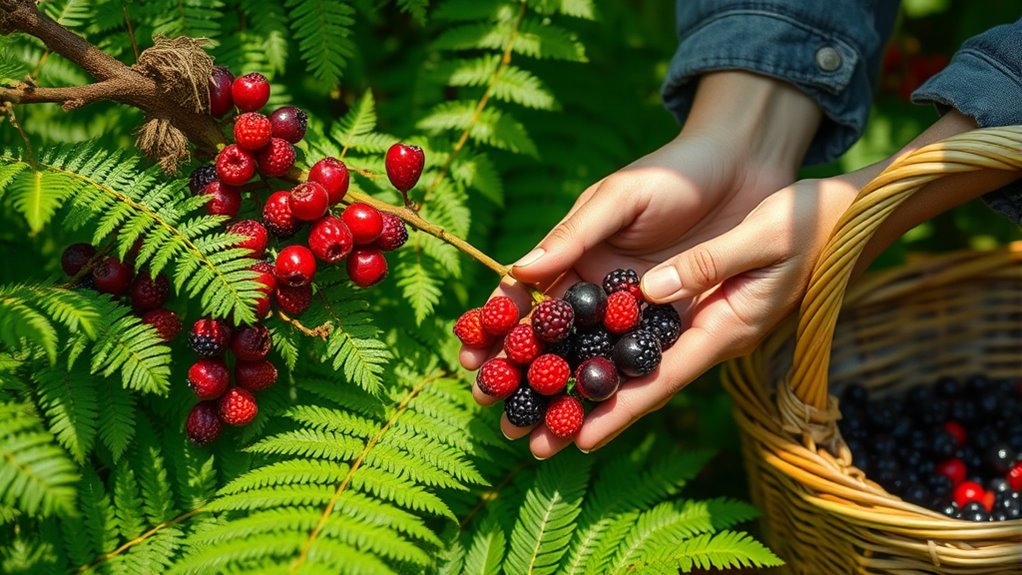
When harvesting wild berries, using the right tools and techniques guarantees safety and preserves the quality of your harvest. Use small, handle-equipped containers like baskets or buckets with straps to prevent crushing delicate berries during harvesting. Wear gloves, long sleeves, and hats to protect against briars, sun exposure, and bugs. Employ scissors or garden clippers to efficiently harvest clusters of berries without damaging the plants. Handle berries gently, preferably keeping whole clusters intact, to minimize bruising and spoilage. Carry a berry picker to speed up the process, but always sort through unripe or rotten berries afterward to maintain quality. Proper handling and protection ensure a safer, more efficient harvest, while preserving the berries’ freshness for later use. Additionally, understanding the best foods for preppers can help you incorporate safe, nutritious options into your foraged bounty. Knowing harvesting techniques can further improve your yield and reduce waste, making your foraging efforts more successful.
How to Properly Identify Edible Versus Toxic Berries
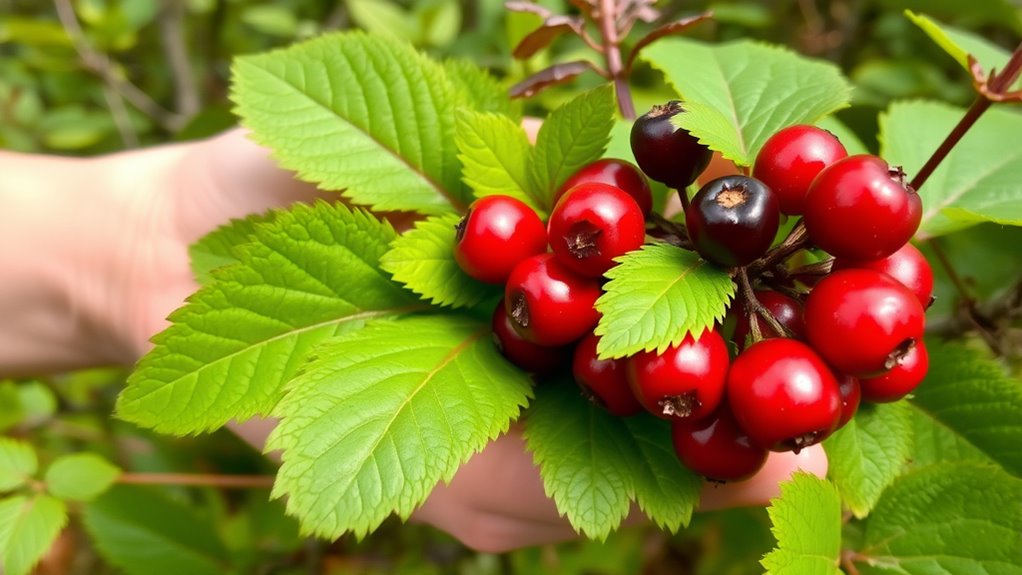
Identifying edible berries accurately is essential for safe foraging, especially since many toxic berries closely resemble safe ones. To properly identify berries, examine plant features such as color, shape, size, and structure. Edible berries like blueberries and blackberries are usually dark blue, black, or purple, making them safer choices, while red, orange, or yellow berries often require caution. Always perform a skin test by gently rubbing the berry on your skin and waiting at least 15 minutes before tasting a tiny amount to check for adverse reactions. Use regional guides or expert resources to confirm your identification, especially for look-alikes. Avoid berries with mold, damage, or growing near pollution sources. When in doubt, err on the side of caution to stay safe. Foraging safety is crucial to prevent accidental poisoning and ensure a rewarding experience. Incorporating predictive analytics can help identify patterns that improve foraging accuracy over time. Additionally, understanding the Power of Imagination can inspire creative ways to learn about regional flora and enhance your identification skills, making foraging both safer and more engaging. Developing a thorough knowledge of plant features can significantly reduce misidentification risks and promote confidence in your foraging practices. Building knowledge about merchant services and the associated risks can also help you better understand the safety measures needed when using digital tools for identification or mapping.
Seasonal Tips for Berry Foraging and Ripeness

Seasonal changes greatly influence when berries are ripe and ready for harvesting. During the summer, ripening varies by species and environment; blackberries and raspberries typically ripen from late June to August, while elderberries appear from August into early fall. In spring, strawberries reach peak ripeness, often in late May or early summer, depending on your climate. To identify when berries are ripe, look for full coloration—dark black or purple for blackberries and elderberries, bright red for raspberries, and deep orange or red for salmonberries. Avoid picking berries that are pale or green, as they’re unripe and possibly toxic. Monitoring local seasonal guides and observing the environment helps you time your foraging accurately, ensuring you harvest berries at their peak flavor and ripeness. Being aware of the ripening process can help you determine the optimal harvest time for different berry species. Additionally, understanding the seasonal variation can enhance your foraging success and safety. Developing patience and attentiveness during the foraging process further improves your ability to select ripe berries at their best. Proper knowledge of seasonal variation can enhance your foraging success and safety. Recognizing trust-building activities during the process can also make your foraging more enjoyable and collaborative.
Ethical and Sustainable Foraging Practices

Practicing ethical and sustainable foraging guarantees that berry harvesting benefits both you and the environment. You should always seek permission before harvesting on private property and follow local regulations to promote ethical foraging. Focus on sustainable harvesting by collecting only what you need, leaving plenty of berries for wildlife, and supporting ecosystem preservation. Use careful plant identification to distinguish native edible berries from toxic lookalikes, preventing harm. Employ responsible foraging techniques, such as gently picking berries without uprooting plants or damaging roots, to maintain plant health. Avoid overharvesting from the same spot repeatedly, which helps conserve local resources and supports conservation practices. Incorporating wildlife protection management practices can also help you stay informed about sustainable foraging guidelines and updates. Additionally, understanding state-specific tax laws can aid in planning your foraging activities around legal considerations and conservation efforts. By adopting these principles, you ensure long-term access to healthy, thriving native edible berries and contribute positively to the ecosystem.
Creative Culinary Uses for Wild Berries

Once you’ve gathered berries responsibly, you can explore a variety of creative ways to enjoy their vibrant flavors. Wild berries lend themselves well to homemade jams, berry preserves, and jellies that highlight their natural sweetness. Use fresh berries as toppings for yogurt, cereal, pancakes, or ice cream for a burst of flavor and color. Many wild berries, like elderberries and chokecherries, are perfect for brewing spirits, wines, or cordials through proper fermentation. Dried berries, such as wild strawberries, can be added to baked goods, trail mixes, or teas, providing a concentrated taste. You can also incorporate wild berries into sauces or desserts, enhancing their culinary uses and making the most of your foraging bounty.
Preparing and Preserving Your Bounty

To guarantee your wild berries stay fresh and safe to enjoy, proper preparation is essential. Start by washing the berries thoroughly, removing stems, and discarding any damaged or moldy fruit. For preserving, use sterilized jars and sealing techniques to ensure safe storage. Freezing berries involves spreading them in a single layer on a baking sheet, then transferring to airtight containers—this helps maintain flavor and prevents clumping. Drying berries in a low-temperature oven or dehydrator concentrates their sweetness and makes them easy to store. Cooking berries into jams, jellies, or sauces activates natural pectin, extending their shelf life without preservatives. Proper preparation and preserving methods give you a longer, safe storage option, allowing you to enjoy your foraged bounty well beyond the harvest season. Additionally, understanding the history of pinball machines can provide insights into their technological innovations, which can inspire creative ways to enjoy your preserved berries in modern culinary and recreational contexts. Exploring food preservation techniques can further enhance your ability to safely store and enjoy your berries for months to come. Incorporating sound healing science into your culinary routines might even make the preservation process more relaxing and enjoyable. Investing in modern heat pump systems can also improve your home environment, making your kitchen a more comfortable space for food preservation activities.
Frequently Asked Questions
How to Identify Berries You Can Eat?
To identify berries you can eat, look for clusters of blue, black, or purple berries, which are often safe. Avoid brightly colored red or orange ones unless you’re sure they’re edible. Check key features like seed shape, berry size, and plant structure using reliable guides. Steer clear of green, white, yellow, or unripe-looking berries, as they’re usually toxic. Always double-check before tasting or consuming wild berries.
What Is the 1 3 Rule for Foraging?
Think of the 1/3 rule as your safety net in nature’s orchard. When you’re foraging, you wait until berries are at least one-third ripe, like a promise of good flavor and safety. This cautious step prevents you from harvesting unripe, potentially toxic fruit. By respecting this rule, you protect yourself and the environment, ensuring berries reach full maturity to seed new plants and sustain the bounty for future foragers.
How Can You Tell if a Berry Is Poisonous or Non Poisonous?
You can tell if a berry is poisonous or not by examining its color, shape, and growth pattern. Avoid green, white, or yellow berries, as most are toxic. Dark blue, black, or purple berries are more likely safe. Check the seed shape and cluster arrangement, and look for warning signs like thorny or woody plants. Do a skin test or taste carefully, but never rely solely on taste for identification.
What Is the Edible Berry Rule?
The edible berry rule is simple: only eat berries if you’re 100% sure they’re safe. Always verify their identity with multiple trusted sources, like guidebooks or experts. Look closely at their shape, color, and texture, and compare them to known edible varieties. If you’re unsure at any point, it’s best to skip that berry and seek advice. Don’t risk poisoning—trust your knowledge and instincts.
Conclusion
As you wander through the woods, it’s amazing how often nature offers just what you need—if you know what to look for. By respecting ethical foraging and honing your identification skills, you can enjoy the bounty of wild berries safely and sustainably. Sometimes, a chance encounter with a vibrant bush or a hidden patch can turn into your next delicious discovery. Embrace the journey—your next tasty find might just be around the corner.



